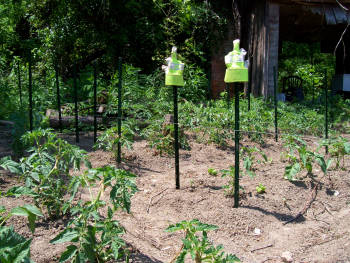
Planting for a Four Season Harvest, Part 4
Mulch
Replaced After Soil Heats Up
 As with the peas, the leaf
mulch is raked aside before planting and
afterwards, when the ground heats up, is raked back again. This
mulch is also necessary over the winter to keep my clay soil from
compacting and getting water-logged; it makes early planting
possible. Using mulch year after year also loosens and lightens
the soil.
As with the peas, the leaf
mulch is raked aside before planting and
afterwards, when the ground heats up, is raked back again. This
mulch is also necessary over the winter to keep my clay soil from
compacting and getting water-logged; it makes early planting
possible. Using mulch year after year also loosens and lightens
the soil.
No special preparation for
planting may be needed; often I just make a
furrow and plant. But for long-rooted crops in clay soil, better
results will be obtained when a two-foot strip along the row is loosed
with a spading fork. This applies particularly to beets, carrots,
parsnips --- all your crops, if there's time. It's not too much
work, and the whole garden can be done in a few years by alternating
rows --- in any one year I never spade up the entire garden.
Mid-April is also the time
for setting out the first-sown tomato
seedlings. Tomatoes are my most important crop; I want 4 months
of fresh tomatoes. The idea --- which I got from Organic
Gardening and Farming
almost 20 years ago --- set out tomatoes so early in the north, even
under protection, at first seemed fantastic. But it works, and
gives an extra month of tomatoes.
I use bottomless glass
jugs, hot caps, sometimes plastic tents, and
keep them on until Memorial Day when young tomato plants are commonly
transplanted into the open garden hereabouts. Choose an early
variety: Moreton Hybrid, Fireball, Geneva, Earliana, Galaxy, Gardener,
Queen's Certified, Burpee's Big Early Hybrid, Breck's Early Red.
"Early" means quick-maturing; in some cases, cold-resistant
too.
Since seedlings can't
usually be bought at this early date and
out-of-the-ordinary varieties of seedlings are always hard to obtain, I
raise my own.
I set out about a dozen and
a half early tomato plants and, after a few
weeks, leave the 10 or 12 sturdiest, discarding the rest. Still
another reason for raising my own --- I couldn't be so prodigal with
bought plants.
To be continued....
Tirrell, R. 1966, February. Planting for a 4-Season
Harvest. Organic Gardening and
Farming.
Reprinted by permission of Organic Gardening magazine. Copyright
Rodale, Inc., U.S.A. All rights reserved.
www.organicgardening.com.
Want more in-depth information? Browse through our books.
Or explore more posts by date or by subject.
About us: Anna Hess and Mark Hamilton spent over a decade living self-sufficiently in the mountains of Virginia before moving north to start over from scratch in the foothills of Ohio. They've experimented with permaculture, no-till gardening, trailersteading, home-based microbusinesses and much more, writing about their adventures in both blogs and books.
Want to be notified when new comments are posted on this page? Click on the RSS button after you add a comment to subscribe to the comment feed, or simply check the box beside "email replies to me" while writing your comment.
